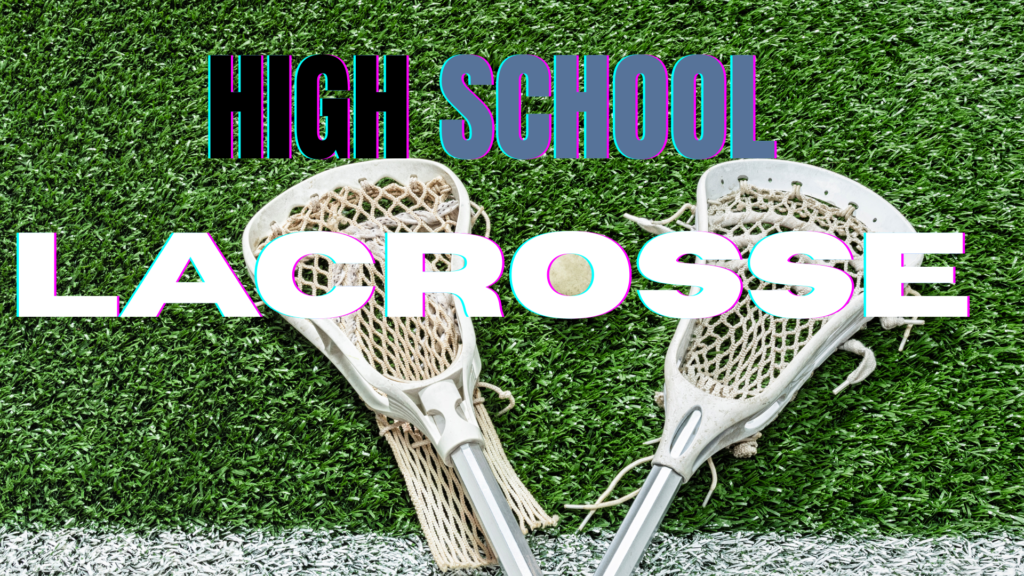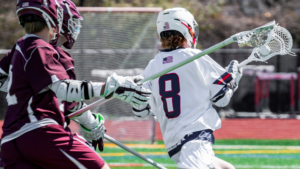High School Lacrosse
- 03/31/2025
- College Recruiting
- 13 mins read

High School Lacrosse: Your Path to College Success and Beyond
High school lacrosse is more than just a sport—it’s a rapidly growing phenomenon that bridges rich historical traditions with modern athletic innovation. Originating from indigenous games played centuries ago, lacrosse has evolved into a dynamic, high-intensity sport embraced by schools across the United States.
Today, high school lacrosse programs are thriving, driven by passionate coaches, dedicated athletes, and communities that value both academic and athletic excellence. This growth not only enriches local sports culture but also creates numerous opportunities for student-athletes to excel on the field and in the classroom.
Whether you are a seasoned high school lacrosse player or just starting out, understanding the impact of high school lacrosse is essential as you prepare for a future in college sports. 🔴🟢
Introduction to High School Lacrosse and Its Growing Impact
The History and Evolution of Lacrosse
Over the centuries, the sport evolved and adopted new strategies and equipment, reflecting changes in technology and societal values.
Today, high school lacrosse stands as a symbol of resilience and adaptability, seamlessly blending ancient traditions with modern athleticism.
High school lacrosse programs have capitalized on this rich history to inspire a new generation of athletes who appreciate the game’s heritage while embracing innovative training techniques and advanced strategies.
Learn more about the evolution of the sport on Wikipedia: College Lacrosse.
🥍 The Rise of High School Lacrosse
In recent decades, high school lacrosse has experienced an unprecedented surge in popularity. With more schools investing in state-of-the-art facilities and experienced coaching staffs, the level of competition has soared.
Communities rally behind local teams, creating vibrant atmospheres that foster team spirit and athletic excellence.
This rise is not just about winning games—it’s about developing leadership, discipline, and strategic thinking.
Increased visibility has also paved the way for enhanced recruitment opportunities and scholarship prospects, ensuring that talented high school lacrosse players have a clear pathway to collegiate sports success. 🔴🟢
The Technical Side and Strategies of High School Lacrosse
🥍 Essential Skills and Drills
High school lacrosse demands a blend of speed, agility, and precision. To succeed, players must master essential skills like accurate passing, shooting on goal, and dynamic defensive positioning.
Coaches emphasize drills that focus on stick handling, quick footwork, and effective communication on the field.
Regular practice sessions often include repetitive drills simulating game conditions, allowing athletes to build muscle memory and enhance reaction times.
For instance, practicing with weighted sticks or engaging in small-sided games can significantly boost technical proficiency.
These foundational drills are critical for both individual improvement and team cohesion, ensuring every player is ready to make split-second decisions during intense game moments.
High School Lacrosse
🥍 Tactical Strategies for Game Day
Beyond individual skills, understanding game tactics is paramount. High school lacrosse strategies involve meticulous planning—from setting up offensive plays to organizing robust defensive lineups.
Coaches typically break the game into phases—transition, possession, and counter-attack—to create a structured approach.
For example, during transition, players must quickly shift from defense to offense, often relying on fast breaks and precise passes to capitalize on opponents’ disorganization.
On defense, strategies like zone defense or man-to-man marking can neutralize the opposition’s strengths.
Effective implementation of these tactics not only boosts team performance but also instills a deep sense of responsibility and discipline in each player, enhancing overall lacrosse IQ.
🥍 Training and Conditioning Tips
A strong training regimen is the backbone of any successful lacrosse program.
High school lacrosse players must dedicate themselves to both on-field practice and off-field conditioning to build endurance, strength, and flexibility.
Training sessions often include high-intensity interval training (HIIT), agility ladder drills, and resistance workouts to ensure players remain competitive throughout the season.
Proper warm-up and cool-down routines are critical to prevent injuries and facilitate muscle recovery.
Nutrition also plays a key role—eating a balanced diet rich in proteins, carbohydrates, and healthy fats can significantly improve performance and recovery.
Incorporating mental conditioning techniques such as visualization and stress management further enhances an athlete’s focus during crucial game moments.
High School Lacrosse
🚨Navigating the Recruitment Process and Scholarship Opportunities
College Lacrosse Recruitment: What Coaches Look For
College coaches are on the lookout for well-rounded student-athletes who demonstrate exceptional lacrosse skills along with strong academic performance and leadership qualities.
When evaluating recruits, coaches assess technical abilities, game intelligence, physical fitness, and character.
They seek players who can excel under pressure, contribute to team dynamics, and continuously learn and improve.
Effective communication on and off the field is also essential for building team cohesion.
Establishing a strong work ethic and creating a detailed highlight reel that showcases your best plays are crucial steps in catching college recruiters’ attention.
High School Lacrosse
✅ Understanding Scholarship Requirements and Tips
Earning a college lacrosse scholarship is competitive, but achievable with the right preparation.
Scholarships in lacrosse are typically partial aids rather than full rides, especially in equivalency sports.
A balance between athletic prowess and stellar academic records is vital to secure both athletic and academic grants. (the bag)💰
Key factors include maintaining a high GPA, excelling in core courses, and actively participating in tournaments and showcases.
For dual-sport athletes, combining lacrosse excellence with insights from USA Lacrosse events can further boost your recruitment profile.
Notably, Ivy League schools, governed by rigorous standards and not offering athletic scholarships, value students who excel academically and possess strong character.
Researching each school’s scholarship criteria, staying in touch with coaches, and building a robust athletic resume are essential steps.
High School Lacrosse
🔑 Key Recruiting Events, Camps, and Showcases
Attending recruiting events, ID camps, and showcases is one of the most effective ways to gain exposure to college coaches.
These events provide a competitive platform to demonstrate skills, receive direct feedback, and network with other top talent.
Elite programs organized by USA Lacrosse offer specialized training sessions that mirror collegiate practices and attract Ivy League and other top college recruiters.
Participation in these events shows commitment and a proactive approach, which can significantly boost your recruitment profile.
These camps often include one-on-one coaching, scrimmages, and skill clinics, making them invaluable for personal growth and visibility in the recruitment circuit.
High School Lacrosse
📚Balancing Academics, Athletics, and College Preparation
The Role of Academics in College Recruitment
Excelling academically is as important as performing on the field for high school lacrosse players. College recruiters prioritize athletes who manage the dual demands of sports and studies effectively.
A strong academic record—highlighted by high grades in core subjects—is a non-negotiable requirement for securing a spot on a college team.
High school lacrosse players should work closely with counselors to ensure enrollment in NCAA-approved courses and maintain a strong GPA.
For detailed information on course requirements, refer to the NCAA Core Courses
This academic diligence not only enhances eligibility for athletic scholarships but also lays the groundwork for success in college.
High School Lacrosse
🏗️ Building a Robust Player Profile
A comprehensive player profile is a key asset in the recruitment process. Your profile should include detailed statistics, a highlight video, and personal achievements that set you apart from other recruits.
Start by documenting your game stats, training milestones, and academic accomplishments.
A well-organized profile not only showcases your lacrosse skills but also your character, leadership, and potential to excel in a collegiate environment.
Platforms such as Hudl, NCSA, and Elite can help compile your footage, and a personal website can serve as a professional portfolio that coaches can easily access.
This proactive approach demonstrates commitment to both your sport and academic future.
📚 Preparing for College Life as a Lacrosse Athlete
Transitioning from high school to college requires more than just athletic ability—it demands preparedness for a significant lifestyle change.
Prospective student-athletes should thoroughly research potential colleges, attend campus visits, and speak with current players and coaches.
Understanding the academic and social culture of a school can help gauge how well you’ll adapt.
⌚Time management, stress-relief techniques, and a clear vision of your goals are essential as you balance rigorous training schedules with demanding coursework.
Cultivating resilience and maintaining a supportive network of mentors, family, and peers can ease the transition and ensure you thrive both on and off the field.
🥍 The Role of Club Lacrosse and College-Level Competitions
High School vs. Club Lacrosse: What You Need to Know
While high school lacrosse offers a competitive environment, club lacrosse is often the next step for players aiming for college recruitment.
Club teams typically participate in high-level tournaments and showcases that attract the attention of college scouts.
The standardized level of play in club lacrosse allows for a more equitable evaluation of talent, regardless of regional differences.
Playing on a club team not only hones your skills but also provides networking opportunities with top-tier coaches and fellow athletes.
This exposure is invaluable for building confidence and understanding the dynamics of college-level competition, making club lacrosse an essential part of your recruitment journey.
🔍 Overview of College Lacrosse Divisions and Competitions
College lacrosse is divided into various levels, each offering a unique competitive landscape.
The NCAA, NAIA, and MCLA provide different avenues for athletes—ranging from highly competitive Division I programs to more academically focused Division III teams.
Division I programs often offer partial athletic scholarships and feature the most elite athletes, while Division II strikes a balance between athletics and academics.
Division III emphasizes academic achievement with robust athletic programs but without athletic scholarships.
Understanding these distinctions helps target the right programs based on your skill level, academic interests, and long-term goals.
Participation in collegiate tournaments and championships further refines your competitive edge and prepares you for the challenges of higher-level play.
🥍 USA Lacrosse Programs and Ivy League Opportunities
How USA Lacrosse Programs Inspire High School Athletes
The USA Lacrosse organization plays a pivotal role in promoting lacrosse at every level, including the elite Ivy League environment. USA Lacrosse not only governs the sport nationally but also organizes tournaments, clinics, and showcases that bring together the best talent in the country.
These events provide high school athletes with an opportunity to experience top-notch coaching and gain exposure to college recruiters from prestigious institutions, including Ivy League schools.
The organization’s initiatives foster an environment where technical skill development, sportsmanship, and academic excellence go hand-in-hand, ensuring that athletes are well-prepared for the rigorous demands of collegiate lacrosse.
The Ivy League Perspective on Lacrosse Recruitment
Ivy League schools are known for their stringent academic standards and holistic approach to recruitment. Unlike many other Division I programs, Ivy League institutions do not offer athletic scholarships, focusing instead on admitting students who excel both on the field and in the classroom.
Coaches from these schools often attend USA Lacrosse events to identify well-rounded athletes who demonstrate leadership, resilience, and a commitment to excellence.
For student-athletes aiming for an Ivy League education, participating in USA Lacrosse programs and events is crucial. It not only sharpens their lacrosse skills but also builds a competitive profile that aligns with the Ivy League’s academic and athletic ethos.
⚽ Incorporating Multi-Sport Exposure: College Soccer and Lacrosse
In today’s competitive recruitment landscape, multi-sport exposure can offer a significant advantage. Playing both lacrosse and soccer develops a diverse set of skills that translate well across sports—improving agility, spatial awareness, and overall athleticism.
For student-athletes, participating in multiple sports, along with involvement in USA Lacrosse events, not only enhances your athletic resume but also increases your chances of being noticed by top-tier Ivy League programs.
Coaches appreciate the versatility and commitment of athletes who can excel in diverse athletic environments, which can open additional scholarship avenues through academic merit and other forms of financial aid.
🆔 Benefits of Attending Elite ID Camps for Skill Development
Elite ID camps and showcases are critical for gaining exposure in the college recruitment circuit. These events offer intense, focused training sessions that simulate game scenarios, allowing coaches to evaluate your performance in real-time.
Attending these camps not only sharpens your skills but also provides invaluable feedback from experienced coaches, helping you identify areas for improvement.
Whether you attend a lacrosse-specific camp or a multi-sport ID event organized by USA Lacrosse, the exposure and experience gained can significantly enhance your recruitment profile and set the stage for collegiate success, particularly if you aim for Ivy League institutions.
✅ Recruitment, Training, Academics, and Competition: A Quick Overview Table
Aspect | Description | Key Factors | Impact |
Recruitment | Connecting with college coaches through showcases, camps, and personal outreach | Highlight reels, academic records, personalized communication (Elite CoachingandTraining) | Opens doors to college athletic scholarships and opportunities |
Training | Rigorous on-field drills and off-field conditioning routines designed for peak performance | Technical drills, strength & conditioning, injury prevention | Builds endurance, skill, and game readiness |
Academics | Maintaining strong academic performance to meet NCAA eligibility and enhance recruitment profile | GPA, core courses, test scores, time management (NCAA Core Courses) | Essential for balancing athletics with college success |
Competition | Participation in high-level tournaments, club events, and collegiate showcases | Quality of opponents, exposure events, leadership roles | Sharpens competitive edge and builds athletic resume |
🎯 Final Tips, Conclusion, and Next Steps for Aspiring Lacrosse Players
Summary of Key Takeaways
Navigating the world of high school lacrosse is an exciting and multifaceted journey that goes beyond just playing a game.
We’ve explored the rich history and evolution of lacrosse, delved into the technical skills and strategic approaches needed on game day, and provided a comprehensive guide to the recruitment process and scholarship opportunities.
Balancing academics with athletics is crucial, and building a robust player profile along with attending elite events organized by USA Lacrosse can significantly boost your chances of collegiate success—especially for Ivy League-bound athletes who must meet high academic standards.
Remember, consistent effort, strategic planning, and a passion for continuous improvement are the keys to unlocking your full potential as a student-athlete. 🔴🟢
💥 Call-to-Action for Further Learning and Engagement
If you’re ready to take your high school lacrosse journey to the next level, start by setting clear goals and planning your path carefully. Explore local club teams, sign up for elite ID camps, and actively engage with college recruiters.
Don’t hesitate to reach out to the staff and college recruiting coordinators at Elite for personalized advice and updated college recruiting scholarship tips. Your future as a collegiate athlete begins with the steps you take today—so lace up, hit the field, and let your passion shine!
FREQUENTLY ASKED QUESTIONS
Developing strong stick handling, precise passing, and effective shooting techniques is essential. Equally important are tactical skills such as defensive positioning and transition play. Consistent practice, focused drills, and participation in competitive games are key to mastering these skills and standing out during recruitment.
Balancing both requires discipline and time management. Prioritize your schoolwork by creating a schedule that allocates specific time slots for study, practice, and rest. Utilize planning tools and work closely with your counselors to ensure you meet NCAA-approved course requirements while maintaining peak athletic condition.
Your profile should be comprehensive, highlighting your game statistics, academic achievements, and personal attributes. Include a well-edited highlight video that showcases your best plays, your athletic resume, and any accolades you’ve received. Personalize your communications with coaches to reflect your genuine interest in their program.
Elite ID camps and events organized by USA Lacrosse offer high-level training that mirrors college practices. These camps provide exposure to college recruiters, allow you to receive expert feedback, and help you gauge your performance against top talent. They are pivotal in bridging the gap between high school competition and collegiate athletics—especially for Ivy League programs that value academic excellence.
Multi-sport participation, such as playing both lacrosse and soccer, enhances overall athleticism by developing diverse skill sets, improving agility, and increasing endurance. Coaches value versatility and the ability to perform across different athletic environments, which can open additional scholarship opportunities and broaden your recruitment prospects.





